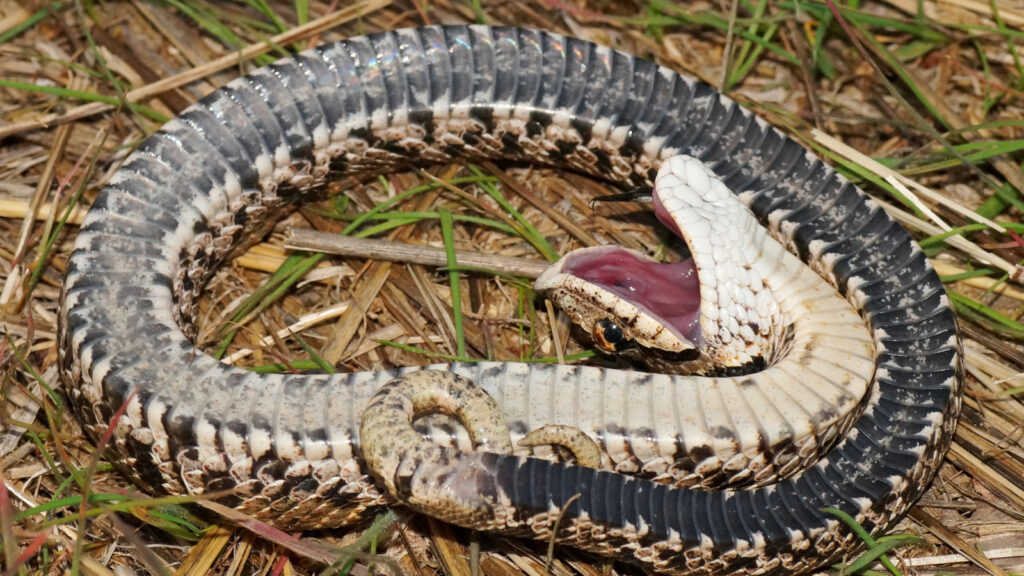Snakes escape predators by playing dead — and they make their performances even more convincing by smearing themselves with their own blood and feces, scientists have discovered.
Playing possum is common in the animal kingdom. Various insects, fish, amphibians, reptiles, birds and mammals all fake their own mortality in last-ditch efforts to fool predators. This behavior is known as death feigning or thanatosis.
In a paper published May 8 in the journal Biology Letters, researchers described how dice snakes (Natrix tessellata) take their Shakespearean theatrics to the next level.
When confronted by a predator, the snakes expel fecal matter and musk, a putrid digestive byproduct. They then flop on their backs and feign death, and sometimes they begin bleeding from the mouth, likely in an attempt to make themselves a less-appealing meal.
“Death feigning is a high-risk, high-reward behavior. If you feign death, you’re completely helpless, so it would be nice if you have some sort of protection against just being instantly consumed,” lead author Vukašin Bjelica, a biologist at the University of Belgrade, told Live Science.
Dice snakes reach maximum lengths of about 4 feet (1.2 meters) and are nonvenomous, so they have few defenses against larger mammals and birds in their native range of Europe, Asia and northern Africa.
But by deploying this suite of behaviors — known as a defense portfolio — dice snakes can make themselves seem unappetizing. The stench of the feces and musk and the bloody drool leaking from their mouths may give the impression that the snake is a rotting carcass rather than a fresh piece of meat.
Get the world’s most fascinating discoveries delivered straight to your inbox.
Related: Slow-motion footage of snake attacks reveals surprise discovery about how they kill
The revulsion and confusion that this macabre display evokes in a potential predator may provide just enough time for the snake to escape or even induce the predator to abandon its efforts entirely.
The researchers focused on a population on Golem Grad, an island in Lake Prespa, North Macedonia. This population appears to be more predisposed to thanatosis than other populations of dice snakes.
“The dice snakes from Golem Grad are in a peculiar set of circumstances. First of all, there is an intense avian predation pressure. Second, these snakes are rather large when compared to their mainland relatives,” Bjelica said. “Being big is good if you’re faced off against a gape-limited predator such as some birds.”
They tested 263 dice snakes on the island by handling them in ways that simulated how a predator might approach its prey — grasping, holding and stretching its body. Of these snakes, 124 smeared feces on their bodies. Twenty-eight bled from the mouth — a phenomenon called autohemorrhaging or reflex bleeding.
Bjelica thinks that individual personalities may determine whether the snakes engage in this behavior. “Some individuals are more bold — prone to risks — or shy — less likely to engage in risky behavior,” he said.
Only one juvenile snake bled from the mouth, indicating that this behavior is more common in adults, and it may be too much of a risk for smaller snakes. “Juvenile snakes are smaller than adults and can easily be consumed. This might be one of the reasons they avoid this risky display,” Bjelica said.
Dice snakes that expelled feces and musk and then bled from the mouth spent less time in a death-feigning state, the researchers found. The snakes that used fecal smearing and mouth bleeding spent an average of 2 seconds less in thanatosis, which the researchers believe to be significant survival advantage.
These snakes are not the only animals known to go the extra mile when playing dead. Virginia opossums (Didelphis virginiana) may defecate and drool while feigning death, indicating that this evolutionary strategy has proven useful across the spectrum of animal life.
>>> Read full article>>>
Copyright for syndicated content belongs to the linked Source : Live Science – https://www.livescience.com/animals/snakes/snakes-use-blood-and-feces-to-convince-predators-they-are-dead
